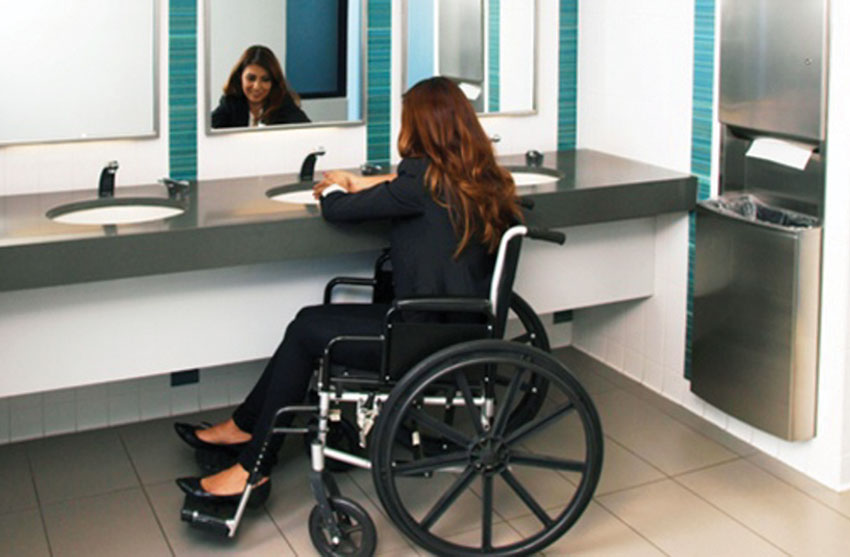New Accommodations for Diversity
Learning Objectives:
- Identify how the prescriptive requirements for accessible restroom design, as mandated by ADA, accommodate a diverse set of users.
- Recognize the changes in the ICC A117.1-2017 Accessibility Standards for existing and new buildings.
- Describe requirements for accessible lavatories and restroom accessories.
- Specify accessible toilet compartments of varying sizes under the new prescriptive requirements and select the accessories needed to complete their specification.
- Discuss requirements for accessible bathing facilities.
Credits:
This course is approved as a Structured Course
This course can be self-reported to the AANB, as per their CE Guidelines
Approved for structured learning
Approved for Core Learning
This course can be self-reported to the NLAA
Course may qualify for Learning Hours with NWTAA
Course eligible for OAA Learning Hours
This course is approved as a core course
*State-certified members self-report 1 ADA State Accessibility/Barrier-Free
This course can be self-reported for Learning Units to the Architectural Institute of British Columbia
Public restrooms are an essential building amenity and, as such, need to adapt to a wide range of human abilities. To ensure proper accommodation, prescriptive requirements mandate standards for both new and existing buildings. For design professionals to achieve their vision and better serve occupants, it is important to understand the impacts of these requirements. Understanding how to specify for accommodation can work in tandem with the desire for coordinated aesthetics, improved operating costs, hygiene, compliance, and sustainability.

Photo courtesy of Bobrick Washroom Equipment
Today’s accessibility standards accommodate a diverse set of users.
Prescriptive Codes And Standards
Public restrooms are an essential feature of the built environment. They must also accommodate many diverse groups and be responsive to a wide range of abilities and disabilities. Though wheelchair access is a primary basis of design in the standards, accommodations in washrooms can benefit a wide range of users, including people with health problems, the elderly, children, and caregivers.
The Americans with Disabilities Act (ADA) is a federal civil rights law that prohibits discrimination against people with disabilities by ensuring equal access to goods and services. It recognizes inaccessible washroom facilities as a form of discrimination since inaccessible facilities can exclude participation in public activities or the workplace by people with disabilities. The Americans with Disabilities Act (ADA) sets the minimum requirements, both scoping and technical, for newly designed and constructed, or altered, state and local government facilities, public accommodations, and commercial facilities to be readily accessible to and usable by individuals with disabilities. For restroom design, this means some of each type of fixture or feature, as well as the installation location, must meet accessibility requirements contained in the 2010 ADA Standards for Accessible Design. In addition, many projects must also follow the provisions of the 2017 Edition of ICC A117.1, Accessible and Usable Buildings and Facilities, certified by the American National Standards Institute or ANSI.
The new ICC A117.1-2017 Standards, published in May 2017, will become widely effective as jurisdictions adopt this latest version. The 2021 Edition of the International Building Code (IBC) refers to ICC 2017 A117.1. As county, local, and state authorities adopt IBC 2021, they will be enforcing 2017 ICC A117.1. In recent years, states such as California, Hawaii, Massachusetts, and Texas have not adopted the A117.1 standard. Instead, these states have harmonized their accessibility standards with the 2010 ADA Standard or developed their states’ accessibility standards to exceed the minimum ADA requirements.
Because the 2017 ICC Standards will soon be adopted by many states and local jurisdictions, there will be significant jurisdictional overlap with the 2010 ADA Standards for many projects. The 2010 ADA standards and the 2017 ICC Standards are similar; however, there are some differences in the scope of their requirements and in technical specifications. Individual states may also have their own accessibility standards. When working on projects with ADA, ICC A117.1-2017, and state accessibility standards, the most stringent of the standards should be followed.

Photo courtesy of Bobrick Washroom Equipment
The Americans with Disabilities Act (ADA) sets the minimum requirements, both scoping and technical, for newly designed and constructed, or altered, state and local government facilities, public accommodations, and commercial facilities to be readily accessible to and usable by individuals with disabilities.
General Prescriptives
Accessibility standards compliance is founded on a set of “building blocks.” These “building blocks” include dimensional requirements stated as minimums and maximums.
The 2010 ADA Standards designate clear floor space to accommodate a single wheelchair. Wheelchair dimensions and movements are used as a primary source of design information for accessible restrooms in terms of amount of space and paths of travel. Clear floor space at lavatories, urinals, and baby changing stations must be positioned for forward approach. A portion of the clear floor space may be located under countertops, lavatories, or other accessories if the required knee and toe clearance is provided. Clear floor space at other restroom elements, such as paper towel dispenser and waste receptacle units, and hand dryers, can be positioned for both front and parallel or side approach. If properly centered in front of controls and operating mechanisms, the clear floor space will allow both left- and right-hand access.
Mounting heights for restroom accessories may vary within a facility, depending on the location of individual accessories. The fixed nature of the equipment imposes finite space requirements and particular limits on the reach ranges of users. To allow use by people with limited reach ranges, it is required that accessories, other than toilet tissue dispensers, be mounted with their operable parts, like dispensing mechanisms, start buttons, electronic sensors, coin slots, or dispenser openings, located no more than 48 inches above the finish floor.
In the state of California, the maximum height for operable parts is 40 inches, not the 48-inch maximum in the 2010 ADA and ICC A117.1-2017 standards. The operable portions of toilet tissue dispensers should be mounted no lower than 15 inches above the floor per the ADA. The ICC A117.1-2017 Standard limits the operable portions of toilet tissue dispensers to no lower than 18 inches. The ICC A11.7-2017 Standard has an Exception that allows dispensers that accommodate two rolls no more than 5 inches in diameter to be located 7 inches to 9 inches from the dispenser centerline to leading edge of the toilet. The dispenser outlet should be a minimum of 15 inches above floor. In the state of California, operable portions of toilet tissue dispensers should be mounted no lower than 19 inches above the floor.
Where accessories are mounted over obstructions such as counters, their operable parts must be located a maximum of 48 inches above the finish floor when the obstruction is 20 inches or less deep, and a maximum of 44 inches above the floor when the obstruction is 20 inches or more deep.
When determining the mounting location of restroom accessories, it is important to account for side and forward approaches. It is highly recommended that one set of each type of dispenser be located outside of the toilet compartment, on an accessible route for increased convenience.
When designing restrooms primarily for children’s use, select the dimensions that are most appropriate for the specific children’s age group for which the project is designed. Mounting heights for children vary depending on age. Ages are grouped as follows: children aged 3 and 4, 5 through 8, and 9 through 12 years. ADA offers recommended heights for each age group; however, these dimensions are not required standards.

Image courtesy of Bobrick Washroom Equipment
Height ranges of bathroom accessories.

Photo courtesy of Bobrick Washroom Equipment
Accessible restroom design also enables users with visual challenges to navigate safely.
















